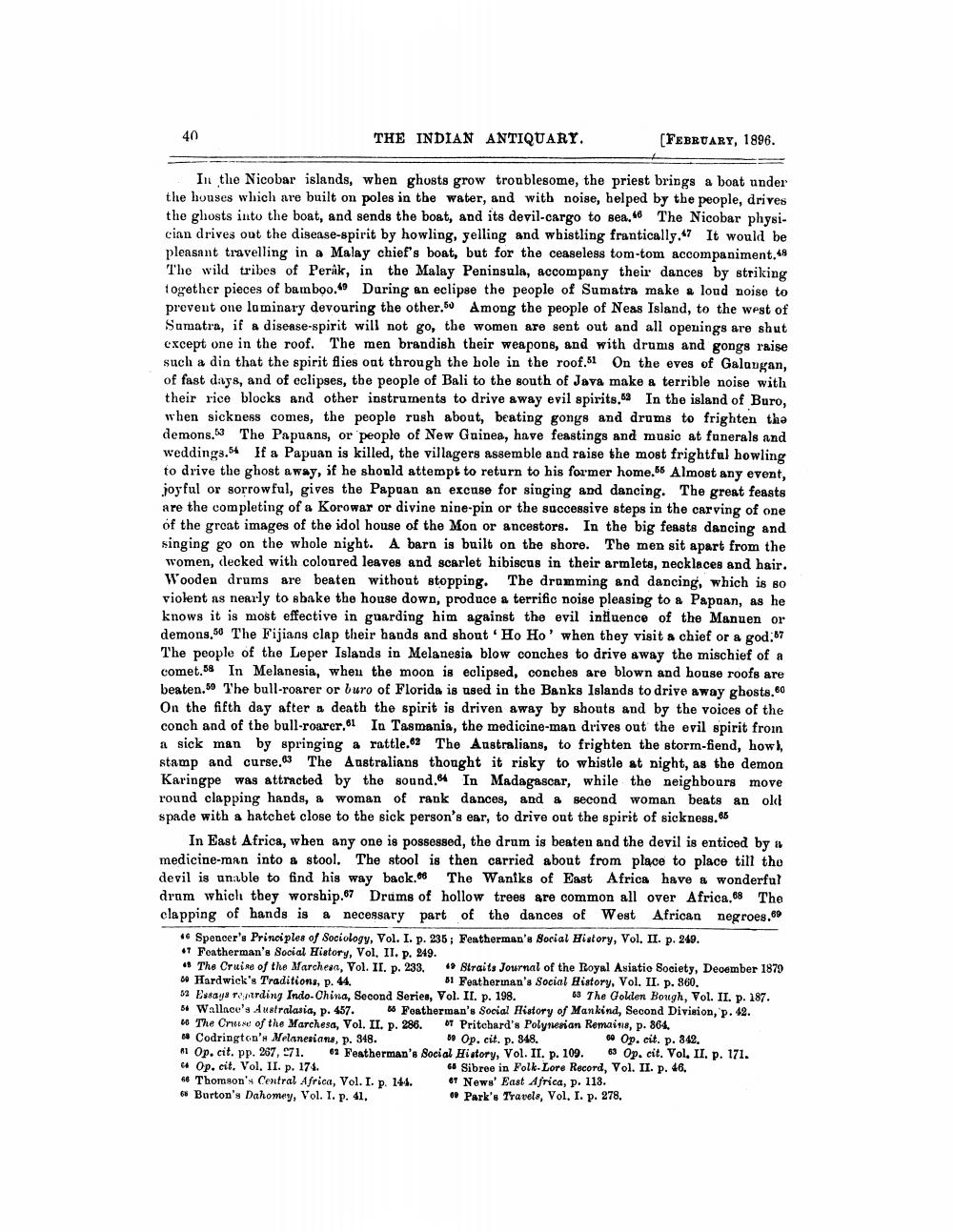________________
THE INDIAN ANTIQUARY.
[FEBRUARY, 1896.
In the Nicobar islands, when ghosts grow troublesome, the priest brings a boat under the houses which are built on poles in the water, and with noise, helped by the people, drives the ghosts into the boat, and sends the boat, and its devil-cargo to sea. The Nicobar physician drives out the disease-spirit by howling, yelling and whistling frantically. It would be pleasant travelling in a Malay chief's boat, but for the ceaseless tom-tom accompaniment.19 The wild tribes of Perak, in the Malay Peninsula, accompany their dances by striking together pieces of bamboo. During an eclipse the people of Sumatra make a loud noise to prevent one laminary devouring the other.50 Among the people of Neas Island, to the west of Sumatra, if a disease-spirit will not go, the women are sent out and all openings are shut cxcept one in the roof. The men brandish their weapons, and with drums and gongs raise such a din that the spirit flies oat through the hole in the roof.51 On the eves of Galangan, of fast days, and of eclipses, the people of Bali to the south of Java make a terrible noise with their rice blocks and other instruments to drive away evil spirits. In the island of Buro, when sickness comes, the people rush about, beating gongs and drums to frighten the demons. The Papuans, or people of New Guinea, have feastings and music at funerals and wedding3.54 If a Papuan is killed, the villagers assemble and raise the most frightful howling to drive the ghost away, if he should attempt to return to his former home.65 Almost any event, joyful or sorrowful, gives the Papuan an excuse for singing and dancing. The great feasts are the completing of a Korowar or divine nine-pin or the successive steps in the carving of one of the great images of the idol house of the Mon or ancestors. In the big feasts dancing and singing go on the whole night. A barn is built on the shore. The men sit apart from the women, checked with coloured leaves and scarlet hibiscus in their armlete, necklaces and hair. Wooden drums are beaten without stopping. The drumming and dancing, which is so violent as nearly to abake the house down, produce a terrific noise pleasing to a Papaan, as he knows it is most effective in guarding him against the evil influence of the Manuen or demons.50 The Fijiang clap their hands and shout Ho Ho' when they visit a chief or a god:57 The people of the Leper Islands in Melanesia blow conches to drive away the mischief of a comet.58 In Melanesia, when the moon is eclipsed, conches are blown and house roofs are beaten. T'he bull-roarer or buro of Florida is used in the Banks Islands to drive away ghosts.60 On the fifth day after a death the spirit is driven away by shouts and by the voices of the conch and of the bull-roarer. In Tasmania, the medicine-man drives out the evil spirit froin a sick man by springing a rattle.62 The Australians, to frighten the storm-fiend, howl, stamp and curse.63 The Australians thought it risky to whistle at night, as the demon Karingpe was attracted by the sound.64 In Madagascar, while the neighbours move round clapping hands, a woman of rank dances, and a second woman beats an old spade with a hatchet close to the sick person's ear, to drive out the spirit of sickness.86
In East Africa, when any one is possessed, the drum is beaten and the devil is enticed by medicine-man into a stool. The stool is then carried about from place to place till the devil is unable to find his way back. The Waniks of East Africa have a wonderful dram which they worship.67 Drums of hollow trees are common all over Africa.68 The clapping of hands is a necessary part of the dances of West African negroes.
• Spencer's Principles of Sociology, Vol. I. p. 235; Featherman's Social History, Vol. II. p. 249. *7 Featherman's Social History, Vol. II. p. 949. • The Cruise of the Marchesa, Vol. II. p. 233. Straits Journal of the Royal Asiatic Society, December 1879 - Hardwick's Traditions, p. 44.
01 Featherman's Social History, Vol. II. p. 360. 52 Essays Teyrding Indo-China, Second Series, Vol. II. p. 198.
63 The Goklen Bough, Vol. II. p. 187. Wallace's Australasia, p. 457. Foatherman's Social History of Mankind, Second Division, p. 42. - The Crane of the Marchesa, Vol. II. p. 286. 07 Pritchard's Polynesian Remains, p. 864. # Codrington's Melanesians, p. 348.
0 Op. cit. p. 348.
60 Op. cit. p. 342. 11 Op.cit. pp. 267, 971. 2 Featherman's Social History, Vol. II. p. 109. 03 Op. cit. Vol. II. p. 171. • Op. cit. Vol. II. p. 174
6 Sibree in Foll-Lore Record, Vol. II. p. 46. 4 Thomson's Central Africa, Vol. I. p. 144. 07 News' East Africa, p. 113. 6 Burton's Dahomey, Vol. 1. p. 41.
Park's Travels, Vol. I. p. 278.




